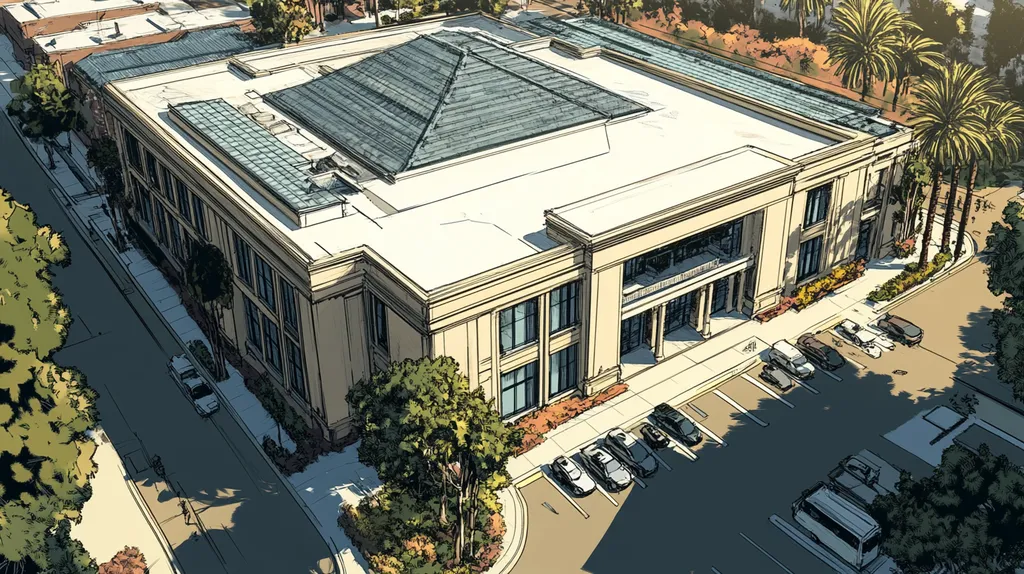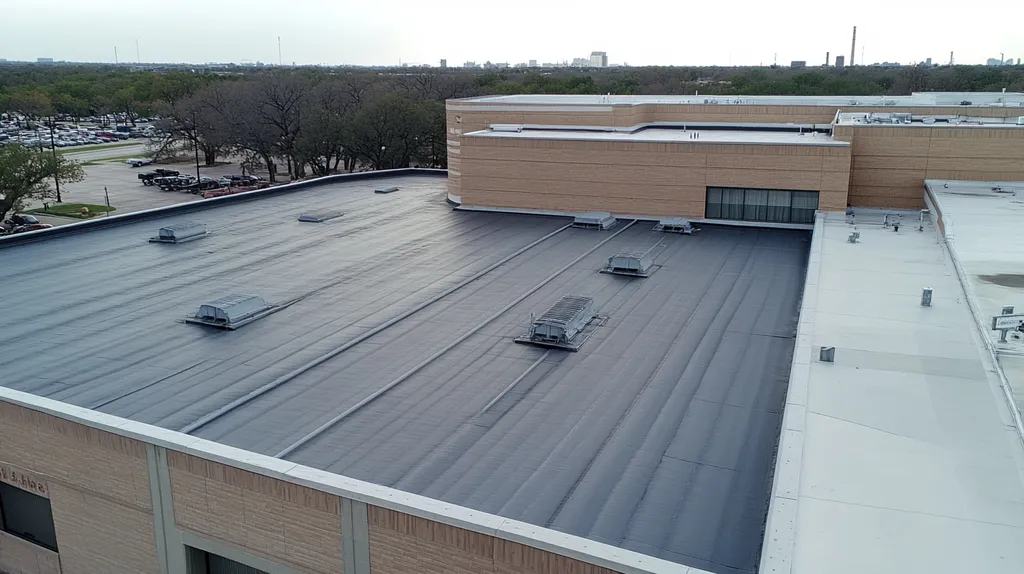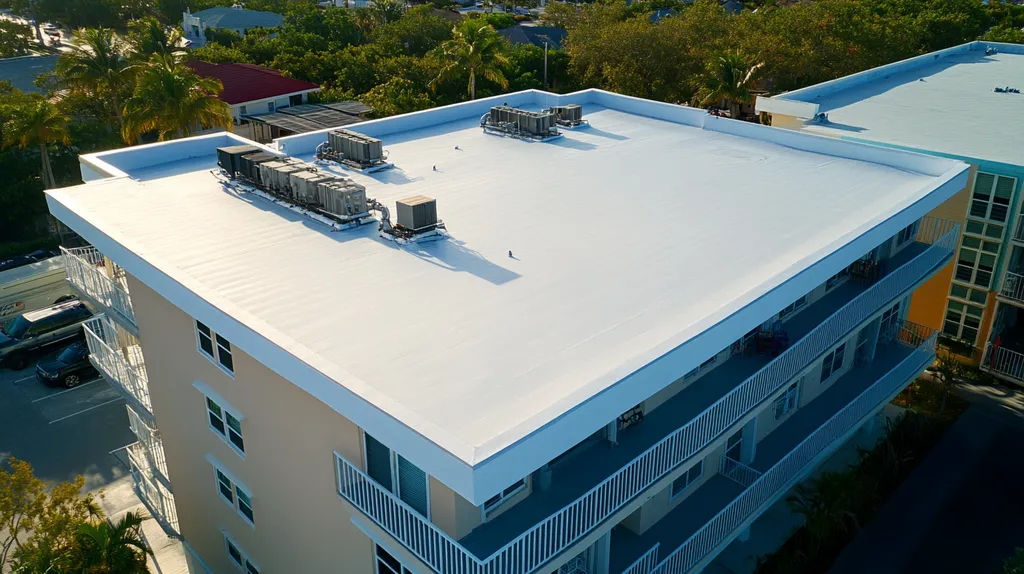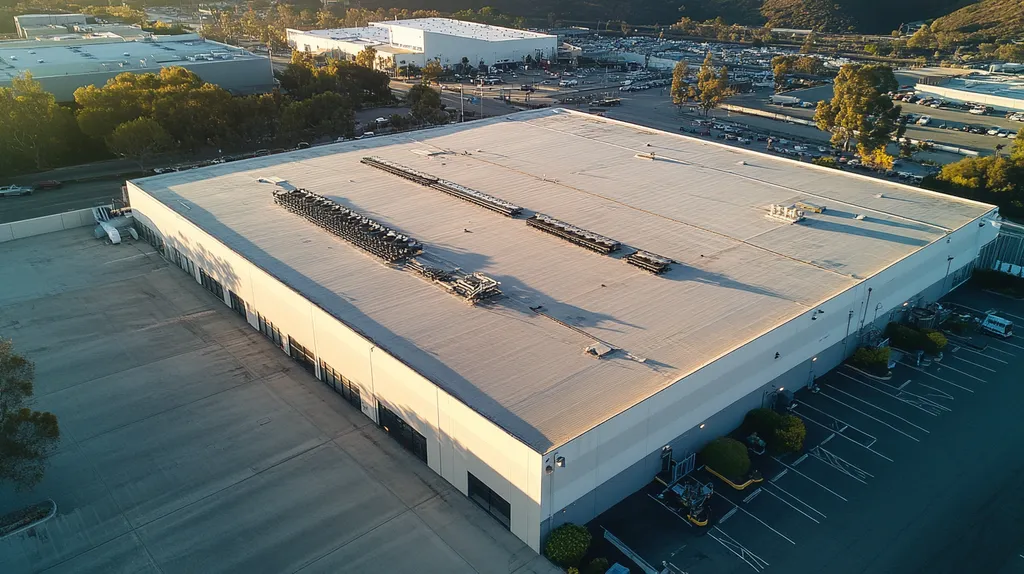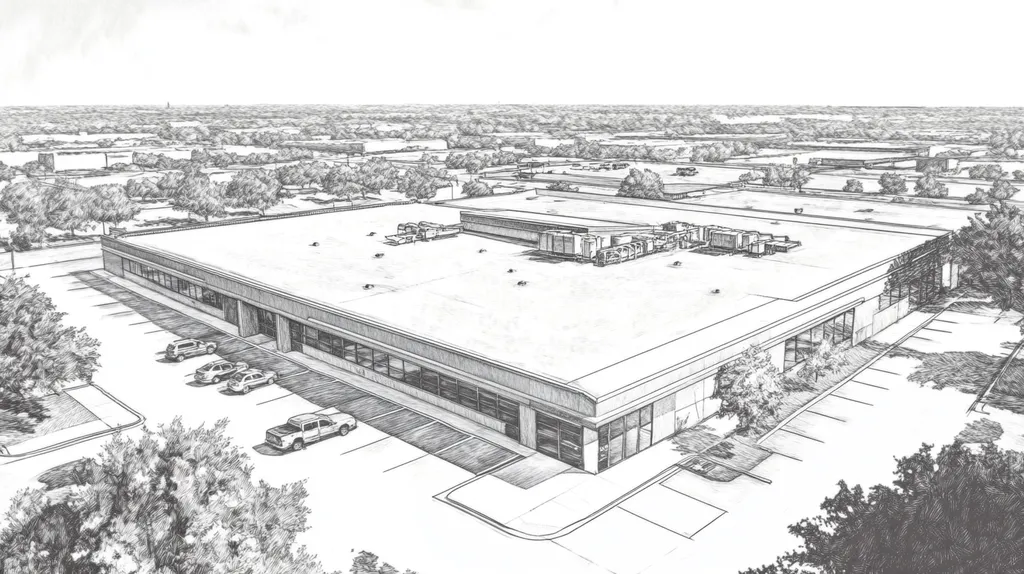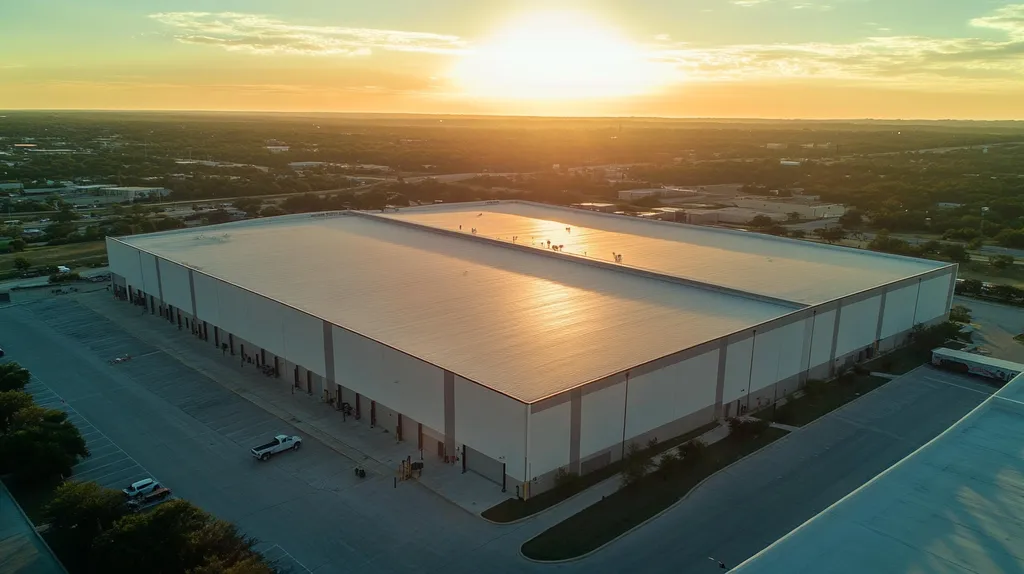Weather-related damage accounts for over 70% of commercial roof failures, with repair costs surging past $5 billion annually across North America. Recent NOAA data shows extreme weather events have increased by 400% since 1980, creating unprecedented challenges for facility managers.
Without proper preparation and response protocols, even minor weather events can escalate into major structural issues that threaten business continuity and safety.
This guide provides facility managers with actionable strategies for assessing weather impacts, implementing cost-effective repairs, and maintaining regulatory compliance while protecting their roofing investments.
SECTION 1: PERFORMANCE FACTORS
Weather conditions significantly impact the effectiveness and lifespan of commercial roof systems. Severe weather events are responsible for up to 70% of roof failures, making it crucial for facility managers to grasp the factors that influence roof performance. This section delves into how to assess weather resistance, evaluate roof system durability, and understand the effects of various weather elements on roofing materials.
Assessing Weather Resistance
Understanding weather resistance is vital to ensuring a roof’s capability to handle environmental challenges. This assessment requires familiarity with how diverse materials respond to elements like rain, snow, and heat. For instance, high-quality roof membranes play a critical role in preventing leaks and enhancing overall roof longevity.
Moreover, the insulation properties of various roofing systems are essential to consider. Effective insulation not only improves energy efficiency but also influences how materials react to temperature changes. In regions prone to severe weather, investing in durable insulation is vital for maintaining peak roof performance.
Regular maintenance checks are instrumental in boosting weather resistance. During these inspections, facility managers should identify signs of wear, damage, or sealing inadequacies. Catching these issues early is key to minimizing severe damage when weather conditions take a turn for the worse.
Employing advanced technologies like thermal imaging can assist in pinpointing areas vulnerable to weather damage. These proactive measures prepare roofs to better withstand adverse weather conditions, safeguarding the property’s integrity.
Key Action Items
Evaluating Roof System Durability
Durability is a fundamental aspect that influences a roof’s performance over time. Roof systems exposed to harsh weather demand materials designed to endure these stresses. For example, elastomeric coatings are effective at enhancing flat roof durability by adding protection against UV rays and moisture.
Facility managers should also consider the lifespan of various roofing materials. Asphalt shingles typically last between 15-30 years, while metal roofs can endure beyond 50 years with proper care. Choosing the right material based on local weather conditions is crucial for long-term durability.
Moreover, the roof’s slope is a significant factor in drainage efficiency. A steep slope aids in water runoff, reducing the risk of pooling, whereas flat roofs require meticulous drainage systems to avoid trapped water.
The building’s surrounding environment further influences durability. Structures in urban areas may face more pollution and debris, necessitating more frequent maintenance. Recognizing these factors enables facility managers to select roofing systems that provide both durability and performance.
Key Action Items
Impact of Weather on Roof Materials
Understanding how different weather elements affect roofing materials is crucial for facility managers. For example, hail can severely damage membrane roofs while having a lesser impact on metal roofs. Knowing which materials withstand specific weather conditions better is essential in selecting an appropriate roofing system.
In addition, temperature changes can cause thermal expansion and contraction, which may compromise certain materials over time. PVC roofs are particularly vulnerable to these effects, whereas TPO roofing tends to offer better stability across varying temperatures.
Moisture poses another significant challenge that can greatly affect roof performance. Excessive moisture can foster mold growth and diminish insulation effectiveness. Therefore, using moisture-resistant materials is vital in regions with substantial rainfall.
Facility managers should actively monitor roof conditions, especially following severe weather incidents. Conducting post-storm assessments allows for the timely identification of weather-induced damage and informs upcoming maintenance strategies. A deep understanding of these weather impacts is essential for sustaining effective and durable roofing solutions.
Key Action Items
SECTION 2: FINANCIAL CONSIDERATIONS
Weather-related repairs can quickly become a financial burden, straining the budgets and cash flow of facility managers. Recent data from the National Oceanic and Atmospheric Administration indicates a rise in severe weather events, leading to unexpected roofing expenses. Understanding the financial implications of weather damage and planning accordingly is essential for maintaining a healthy facility budget. This section will shed light on repair costs, insurance coverage, and the importance of budgeting for preventative measures.
Cost of Weather-Related Repairs
The cost of repairing roofs damaged by weather can be daunting. For minor issues, the average commercial roof repair may range from $500 to $1,500, while extensive damage could surge past $50,000. These expenses become even more pressing when urgent repairs are necessitated by unpredictable weather, which often leads to increased costs due to rushed jobs and compromised workmanship.
Planning in advance can alleviate some of these financial headaches. Delaying necessary repairs not only magnifies immediate repair costs but can also result in structural damage, leading to further expenses. Regular inspections and maintenance can significantly curb long-term repair costs, making routine upkeep a smart financial strategy.
By forecasting seasonal weather impacts, property owners can proactively identify potential roof issues and budget appropriately, preventing financial surprises later on.
Key Action Items
Insurance Coverage for Storm Damage
Navigating insurance coverage for storm-related roof damage is vital for effective financial planning. Most commercial property insurance policies cover damages caused by severe weather, but specific terms and conditions can vary widely. Facility managers must thoroughly examine their policies to ensure adequate protection against threats like wind, hail, and other significant weather events.
It’s also crucial to be mindful of clauses that might hinder claims when maintenance is neglected. For example, if a claim for a roof leak is denied due to inadequate upkeep of aging materials, the facility may face significant out-of-pocket costs. Therefore, proactive maintenance becomes essential to ensure claims can be filed smoothly.
Documenting all roof inspections and maintenance activities can enhance credibility when substantiating claims post-storm. A well-maintained record helps demonstrate diligence and is invaluable in ensuring prompt insurance settlements.
Key Action Items
Budgeting for Preventative Measures
Investing in preventative measures can yield substantial long-term savings. Facility managers often overlook how regular maintenance and upgrades can provide significant returns on investment. By adopting a proactive budgeting strategy, property owners can tackle potential roof vulnerabilities before they spiral into more significant issues.
Allocating a specific percentage of the overall facility budget for roofing maintenance can ensure timely repairs and necessary upgrades. This might include implementing protective coatings or enhancing the drainage system to prevent costly water damage.
Furthermore, leveraging technologies such as drone inspections or monitoring systems can uncover hidden problems that might lead to future expensive repairs. Allocating budget for these technologies as part of a broad risk management strategy can protect the facility’s financial health.
Key Action Items
SECTION 3: COMPLIANCE REQUIREMENTS
Compliance with roofing regulations is not just about following the law; it significantly affects the safety, functionality, and durability of a roof system. Ignoring these essential guidelines can lead to expensive litigation and create hazardous conditions. Facility managers must prioritize understanding compliance to ensure that roofing repairs are both effective and align with legal standards, ultimately protecting their properties from potential liabilities.
Building Code Compliance
Understanding local building codes is crucial for any roofing repair project. These codes outline the standards for materials, structural integrity, and the weather resistance of roofing systems. For example, some areas require roofing materials to endure specific wind speeds, while others mandate certain energy efficiency standards.
Non-compliance can lead to dire consequences, such as having to redo repairs and facing fines. Additionally, violations can jeopardize insurance claims for future damage. Therefore, facility managers must remain informed about local codes and ensure that all contractors follow them during repairs.
Consulting with local building authorities or licensed professionals can clarify compliance requirements, leading to smoother repair processes while minimizing operational disruptions. Accurate documentation of compliance efforts can also enhance public trust in the facility.
Key Action Items
Adhering to Safety Standards
On any roofing job site, prioritizing safety is essential. Complying with Occupational Safety and Health Administration (OSHA) regulations helps prevent workplace accidents and injuries. These guidelines cover critical areas such as fall protection, required safety training, and the use of personal protective equipment (PPE).
If safety measures are neglected, facility managers risk severe penalties and jeopardize workers’ safety. An incident on-site could lead to injuries, costly litigation, and operational disruptions. Thus, prioritizing safety standards protects both workers and investments.
Implementing regular safety audits and ensuring all workers understand safety protocols is key. Documentation of training sessions further enhances workplace safety culture, contributing to a more efficient environment.
Key Action Items
Regulatory Updates for Roofing
Roofing regulations are not static; they change with advancements in technology and responses to environmental concerns. It’s vital for facility managers to stay informed about these evolving regulations to ensure compliance. For instance, updates may include requirements for using eco-friendly materials or incorporating innovative solutions to boost energy efficiency.
Subscribing to industry newsletters or joining local roofing associations can provide timely updates on regulatory changes. Ignoring these updates may lead to outdated practices that could incur penalties or expose facilities to risks. Lacking knowledge about current regulations can complicate future repair projects.
Building rapport with licensed roofing contractors familiar with existing regulations can simplify compliance. These professionals ensure adherence while advising on best practices that align with the latest standards, thereby enhancing roofing system integrity and value.
Key Action Items
SECTION 4: RISK MANAGEMENT
Effective risk management for commercial roof repairs is essential to protect property assets and ensure continuous operations. Extreme weather events, including hurricanes and heavy snowfall, can lead to severe damage and inflated repair costs. The National Oceanic and Atmospheric Administration (NOAA) reports a surge in the frequency of these severe weather occurrences, presenting immediate challenges for facility managers. This section explores the identification of potential hazards, assessment of damage, and strategies for mitigating risks during roof repairs.
Identifying Potential Hazards
Identifying potential hazards is the foundational step in managing risks for commercial roofs. Facility managers must evaluate their buildings’ locations, noting that some areas are more susceptible to specific severe weather patterns. For instance, properties situated in flood-prone zones may require enhanced waterproofing measures.
Understanding the roofing materials used is also critical. Different materials have varying resistance levels to issues such as wind uplift or hail damage. Establishing a regular inspection schedule can help catch vulnerabilities before they escalate into larger problems.
Additionally, consideration of roof age and condition is vital. Older roofs lacking adequate maintenance are particularly vulnerable to severe weather events. Being aware of these factors allows for strategic planning that can ward off catastrophic failures when storms occur.
Key Action Items
Assessing Damage from Extreme Weather
After extreme weather events, thorough damage assessment is critical to identify all roofing issues effectively. Facility managers should conduct comprehensive roof inspections following any severe weather incident. This includes checking for visible damage like punctures or tears in the roofing material, as well as less obvious signs such as leaks and structural shifts.
Utilizing advanced tools like infrared imaging can help detect hidden leaks that may not be visible outright. This technology uncovers areas where insulation has become wet due to leaks, allowing for prioritized repairs. Regular post-storm assessments are essential to maintaining the integrity of roofing systems.
Documentation of damage is equally important. Keeping detailed records of any identified issues along with repair actions is vital, especially for insurance claims. A thorough assessment can clarify the necessary actions and positively influence financial recovery after severe weather events.
Key Action Items
Mitigating Risks in Roof Repair
Mitigating risks during roof repairs necessitates a strategic planning approach. Selecting the right contractor, one well-versed in addressing weather-related challenges, is paramount. Contractors should be experienced in various repair techniques suited to the specific roofing material.
Prioritizing the scheduling of repairs during favorable weather conditions is also essential. Attempting repairs amid adverse weather can lead to inefficiencies and increased risks. Facility managers should develop action plans that detail repair timelines to ensure swift and safe completion.
Moreover, incorporating preventative maintenance practices can significantly reduce long-term risks. Regular inspections and timely repairs prevent minor issues from escalating into major problems that are costlier and disruptive to resolve.
Key Action Items
SECTION 5: OPERATIONAL PROCEDURES
Weather events pose significant threats to commercial roof systems, often leading to costly damages if not addressed promptly. The National Roofing Contractors Association highlights that severe storms substantially increase the need for repairs, with costs rising dramatically without swift action. To maintain roof integrity, facility managers must adopt proactive measures before, during, and after such events. This section outlines critical actions for preparing for weather events, conducting post-storm inspections, and implementing timely repairs and maintenance.
Preparing for Weather Events
Preparation starts with a comprehensive risk assessment of the roofing system. Facility managers should identify weaknesses, such as loose flashing or aging materials, which may fail during severe weather. A consistent inspection schedule allows for prompt repairs ahead of storms.
A robust communication plan is equally vital. All staff must be informed of emergency protocols, including key contacts for urgent repairs. Keeping a list of trusted roofing contractors readily available can accelerate response times.
Furthermore, ensuring that drains and gutters are clear is essential for directing water away from the roof. Clogged drainage systems risk ponding water, raising the likelihood of leaks. A maintenance checklist dedicated to weather preparedness can help keep roofs in optimal shape.
Key Action Items
Conducting Post-Storm Inspections
Immediate inspections post-storm are vital for assessing potential damage. Facility managers should conduct visual evaluations from the ground, and safely from the roof where possible. Look for signs of membrane damage, punctures, or sections that have lifted, all of which require attention.
Documenting findings plays an essential role in safeguarding future repairs. Capturing photos and notes during inspections can aid discussions with insurance representatives or contractors. Utilizing roof inspection software can streamline this documentation process.
Given that weather may still pose risks, prioritizing safety is crucial. If high winds or rain persist, it’s best to postpone inspections until conditions improve. Facility managers should be ready to act quickly as conditions allow.
Key Action Items
Implementing Repair and Maintenance
Once inspections are complete, implementing required repairs without delay is critical. Postponing repairs can lead to a cascade of additional damages, escalating overall costs. Collaborate with a qualified roofing contractor to evaluate the best repair strategies.
Regular maintenance should also follow repairs to address reoccurring issues and ensure warranty compliance. Consistent upkeep helps extend the lifespan of the roof while minimizing costly repairs.
Furthermore, ongoing education about new materials and technologies can enhance repair strategies. Staying informed about the latest advancements can bolster a building’s resilience against future weather challenges.
Key Action Items
SECTION 5: OPERATIONAL PROCEDURES
Weather events can inflict severe damage on commercial roof systems, making prompt and effective operational procedures crucial. The National Roofing Contractors Association emphasizes that severe storms significantly increase the need for roof repairs, with costs escalating rapidly without swift action. Facility managers must adopt proactive measures before, during, and after weather events to protect roof integrity. This section outlines essential actions for preparing for weather events, conducting post-storm inspections, and implementing timely repairs and maintenance.
Preparing for Weather Events
Preparation for weather events starts with a thorough risk assessment of the roofing system. Facility managers need to identify weaknesses, such as loose flashing or aging materials, which may fail during severe weather. A regular inspection schedule is essential for addressing vulnerabilities ahead of storms.
Establishing a solid communication plan is equally critical. All staff should be informed about emergency procedures, including key contacts for urgent repairs. Maintaining a list of trusted roofing contractors can significantly speed up response times.
Additionally, ensuring that drains and gutters are clear is vital for directing water away from the roof. Blocked drainage systems can lead to ponding water, increasing the risk of leaks. A maintenance checklist focused on weather preparedness can help keep roofs in optimal condition.
Key Action Items
Conducting Post-Storm Inspections
Following a storm, immediate inspections are crucial for assessing possible damage. Facility managers should carry out visual evaluations from the ground and, when safe, from the roof itself. Signs of membrane damage, punctures, or lifted sections must be promptly identified.
Documenting inspection findings plays a pivotal role in future repairs. Taking photos and notes can facilitate discussions with insurance representatives or contractors. Utilizing roof inspection software helps streamline the documentation process.
With weather conditions potentially still hazardous, prioritizing safety is critical. If high winds or ongoing precipitation persist, it may be necessary to postpone inspections. Facility managers should stand ready to act swiftly as soon as conditions allow.
Key Action Items
Implementing Repair and Maintenance
After inspections are complete, implementing necessary repairs without delay is crucial. Postponing repairs can lead to additional damage and increased costs. Work closely with a qualified roofing contractor to determine the best approach.
Regular maintenance should be scheduled following repairs to address recurring issues and ensure compliance with warranty conditions. Consistent upkeep helps to extend the lifespan of the roof while minimizing repair expenses.
Finally, facility managers should engage in ongoing education about new materials and technological advancements. Staying informed on the latest trends can bolster repair strategies and improve overall building resilience against future weather challenges.
Key Action Items
Looking Ahead
Weather-related roofing failures cost North American businesses over $5 billion annually, with severe weather events increasing 400% since 1980.
As extreme weather patterns intensify, facility managers who implement comprehensive inspection protocols and rapid response systems will protect their roofing investments and business continuity.
The key to successful weather impact management lies in proactive planning, from regular assessments to maintaining detailed documentation of all inspections and repairs.
Investing in weather-resistant materials and establishing relationships with qualified contractors before emergencies occur can reduce repair costs by up to 60%.
Those who adapt their roofing strategies to address intensifying weather challenges will maintain safer, more resilient facilities while avoiding costly emergency repairs.
FREQUENTLY ASKED QUESTIONS
Q. How do weather conditions affect commercial roof systems?
A. Weather conditions can drastically influence the lifespan and durability of commercial roofs. Severe weather events can cause roof failures, leading to costly repairs. Understanding how different roofing materials react to elements like rain, snow, and heat is crucial for effective facility management.
Q. What are the financial implications of weather-related repairs for industrial roofs?
A. Weather-related repairs can significantly strain budgets, with costs ranging extensively based on damage severity. Unplanned repairs often arise and can impact cash flow. To mitigate these financial burdens, proactive maintenance and a budget that accounts for potential weather impacts are essential strategies.
Q. Why is compliance with roofing regulations essential for facility managers?
A. Compliance with regulations ensures the safety and functionality of the roofing system. Ignoring these guidelines can lead to expensive legal consequences and unsafe conditions. Understanding local codes, including material standards and safety requirements, is critical for effective roofing management.
Q. How can facility managers identify potential hazards for commercial roofs?
A. Identifying hazards starts with evaluating building locations and existing roof conditions. Regular inspections help catch weaknesses, such as aged materials or vulnerabilities to specific weather patterns. Proper risk management strategies ensure timely action against identified risks, improving roof resilience.
Q. What steps should facility managers take during post-storm roof inspections?
A. Post-storm inspections require visual evaluations from the ground and roof, checking for visible damages. Documenting findings, including taking photos and notes, aids future repairs. Prioritizing safety during inspections is essential, especially in adverse weather conditions.
Q. How can operational procedures help with weather-related roof damage?
A. Establishing operational procedures ensures proactive measures are in place before, during, and after severe weather events. Effective planning includes risk assessments, regular inspections, and clear communication protocols to facilitate rapid responses to potential roofing issues, protecting infrastructure integrity.
Q. What preventative maintenance strategies should be implemented for commercial roofs?
A. Preventative maintenance includes regular inspections, clearing debris from drains, and performing minor repairs to uphold roof integrity. Investing in routine upkeep reduces long-term repair costs, extends roof lifespan, and mitigates risks associated with severe weather events.

